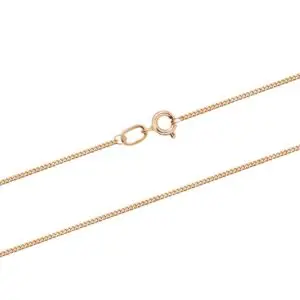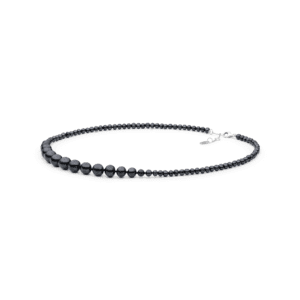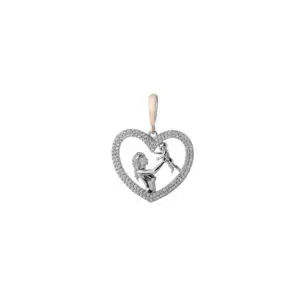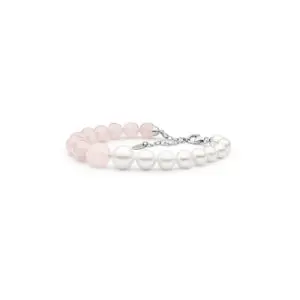Types of gold: carats and colours
Carat and fineness of gold – how to choose?
We usually describe a piece of jewellery as gold or silver. However, you have probably noticed that there is a much wider variety of jewellery out there. When you shop online or in-store, at home or abroad, you come across a selection of jewellery that varies in gold carats and colour. So, the question is what is gold fineness and why does gold come in different colours, and how would you choose?
Carat/fineness/purity of gold is the amount of gold that is in the gold alloy. There are two systems that exist to define this amount: millesimal fineness and carats. Millesimal fineness denotes the purity of gold by parts per thousand of pure gold by mass in the allow. For instance, 585 gold would have 585 parts out of 1000 that is gold with the rest of the parts being some other metals that are usually added to gold alloys. Whereas in the carat system, the purity of gold alloy is measured in parts of 24. The whole alloy is divided into 24 parts, and the carats represent how many of those 24 parts are gold. For example, 18ct gold is made of 18 gold parts and 6 parts that are other metals (with 24 being the total). Both of the systems define the same thing (i.e. fineness of the metal) and which system is used differs between countries. For example, millesimal system is used in Lithuania, whereas carats are used in the United Kingdom.
| Millesimal system/ | Carat system | |
| 333 | 8ct | |
| 375 | 9ct | |
| 417 | 10ct | |
| 585 | 14ct | |
| 750 | 18ct | |
| 999 | 24ct |
Gold in itself as a metal is very soft. Therefore, it would be impractical to make jewellery from pure gold (i.e. 999 or 24ct gold). Such jewellery would bend and scratch very easily and would not last very long. For this reason, jewellery is made from gold alloys, where gold is mixed with other metals (such as silver, copper, platinum and others).
When we know what fineness of gold is, we can question which purity of gold is best and most popular in the jewellery world. That is a very good question, however, there is no one right answer. A lot of the times, the choice depends on one’s habits and cultural traditions. For instance, higher purity gold is liked very much in the east. Whereas in Europe, the most popular choice for jewellery is 585/14ct or 750/18ct gold. However, that does not mean that lower purity gold is not popular. For instance, 9ct (or 375) gold is a very popular choice in the United Kingdom and 8ct (or 333) gold is widely used in Germany. Lower carat gold is more practical as it is harder and it is more difficult to scratch such a piece. Whereas Lithuanians believe that 14ct (or 585) gold is the best choice in terms of price, value and quality. Any choice is good as long as you understand the differences and the reality is that everyone is becoming more and more flexible and even mix jewellery that is different in their fineness when creating a look. A choice might also differ depending on whether one is looking for a wedding band or a luxury ring for a special occasion.
But it is important to note that purity of gold is hallmarked differently in different countries and some differences exist in terms of the lowest fineness that is recognised as a precious metal. In Lithuania, every piece of jewellery is checked and hallmarked in the Assay Office. Therefore, when purchasing an item from a Lithuanian jeweller or retailer, you can look for a hallmark on the item to check the purity of gold. It might be tiny and you will likely need a magnifying glass to see it (as the piece is being protected from damage by punching just a small hallmark), but you will always find one. Interestingly, the lowest recognised purity of gold is 375 (or 9ct) in Lithuania. In comparison, jewellery items need to be checked and hallmarked in the Assay Office only if they are above a certain weight in United Kingdom, which means that smaller items are not verified. Whereas Germany recognises 333 (or 8ct) as the lowest purity of gold.
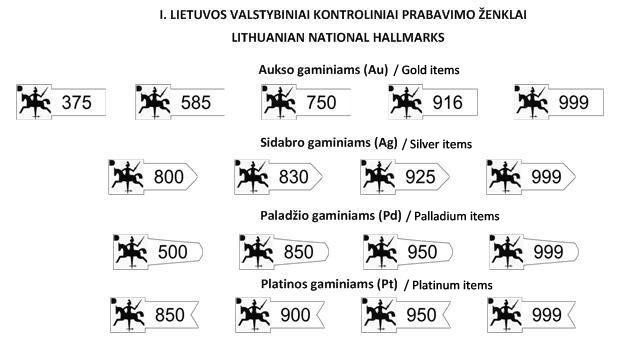
Why does gold colour differ?
Not only can gold differ in purity, but it can also differ in colour. The natural colour of gold is yellow. However, as it was mentioned before, jewellery is not made from pure gold due to practical reasons. Since jewellery is made from gold alloys, its colour depends on the other metals that are added. For example, yellow gold is made by mixing gold with silver, copper and zinc. White gold is made from gold and platinum (or palladium) alloy, which is also very often coated with rhodium. It is difficult to achieve the whiteness level wanted by simply mixing the precious metals in the alloy and white gold made in this way will still have a little bit of yellowish tint. For this reason, white gold items are often coated with rhodium, which makes gold look whiter. Interestingly, rhodium is a very rare and expensive precious metal (more valuable than gold), so no one really makes jewellery from rhodium despite its great qualities. It is only used for coating gold and silver jewellery to increase its attractiveness and durability. Finally, rose gold is made by adding gold, copper and silver in the alloy.
Yellow, white and rose are the most popular colours of gold. However, these colours are not strictly defined and there is an array of tones in colours. For instance, rose gold will be more intense in colour if more copper is added, but it will be lighter when more silver is mixed in. Different jewellers use slightly different alloys and slight differences in colour tones are very normal. Therefore, there is nothing to worry about if you notice that when purchasing a piece of jewellery.
As with fineness of gold, which colour of gold is more valuable and popular might be a good question to ask. However, the truth is that the value of the item does not depend on the colour of gold. Value of a jewellery item only depends on the purity of the gold used to make it. Therefore, the only criterion of choosing the colour should be your own preference. Interestingly, there are differences between countries and cultures in terms of which colour of gold is most popular. For instance, Lithuanians prefer rose gold. In the east, yellow gold is the first choice with white and rose gold being a rare pick. If you visit a store in the United Kingdom, you will find a wide selection of yellow and white gold jewellery pieces with a much smaller selection of rose gold items. Therefore, again there is no right or wrong answer when choosing the colour of gold for your jewellery. In fact, it is getting increasingly more popular to mix different colours, carats and even metals when styling a look, so the sky is the limit!



